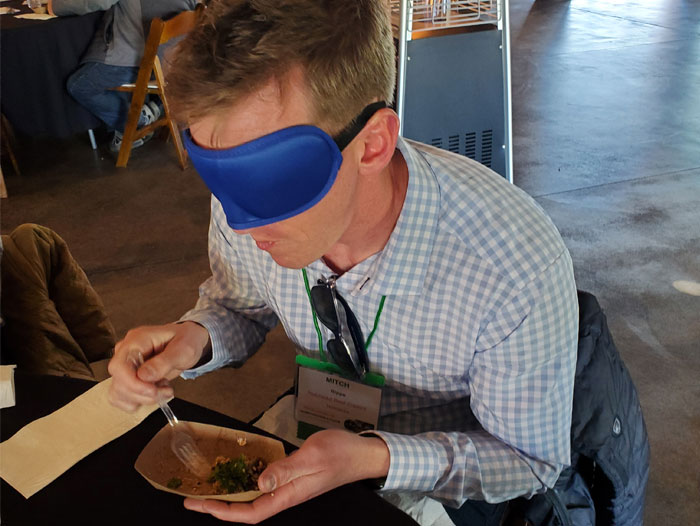“Tasting in the Dark” Enlightens Nutrition Professionals to the Power of the Palate
April 7, 2023 | 5 min to read

Rocklin, CA — Think about this for a moment. You’re sitting in a crowded restaurant. Flatware clatters…glasses clink…laughter punctuates the low thrum of conversations coming from other tables. In the midst of all this, your server appears and sets your meal, steaming hot, in front of you.
What do you do?
Likely, you will look at your plate. But then, almost without thinking about it, you will close your eyes as you inhale deeply.
How many different senses did we employ in this scenario? Hearing, most certainly, as we set the scene with the restaurant noise. Sight, as we looked at the plate set before us. Smell, as we closed our eyes and inhaled the aroma of our meal. We’ve taken in a lot of information, all before we’ve tasted anything. All of the information gathered through your senses—from your surroundings to the aroma of the food–builds your perception of what you are about to taste, and your anticipated enjoyment of it.
Now, remove one sense…sight. What does that do to your perception of the food? How do you perceive flavors and judge a meal if you can’t see it?
That’s what more than 50 registered dietitians and other professionals in the nutrition world experienced when they attended “Shed New Light on Flavor,” a pre-conference workshop produced by the California Beef Council (CBC) in partnership with the National Cattlemen’s Beef Association (NCBA), and the Kansas and Nebraska Beef Councils. The pre-event workshop was offered to attendees of the Academy of Nutrition and Dietetics Food & Culinary Professionals 2023 Culinary Workshop in California’s Napa wine country.
The workshop, held at the beautiful Gambonini Family Ranch in Petaluma, was designed and led by Dr. Hoby Wedler, a Ph.D. chemist and sensory expert who walked attendees through a “Tasting in the Dark” experience. With his highly-trained palate and acute sensory insight, Wedler, who has been blind since birth, talked to attendees about what it means to acquire sensory literacy by opening themselves to all the sensory input around them. “Our understanding and perception is highly dependent on a multitude of sensory and psychological inputs,” Wedler said. “We use vision so much that we’re more literate in that sense than in our other senses, so you need to practice using those other senses.”
Blindfolded attendees sampled four dishes, all including beef in plant-forward meals, all completely unknown to them: a slider that included a beef, bean and mushroom patty; a cold quinoa, fig and goat cheese salad with beef strips; a beef and veggie wrap; and a fajita-style beef street taco that included peppers, squash, tomatoes and onions. Wedler then led them in a still-blindfolded discussion of what they were tasting, what those flavors meant to the dish, how the flavors and textures made them perceive each dish, and what employing their other senses meant to their enjoyment and understanding of the different foods they were eating.
“These pre-event workshops are a way for nutrition and dietetics professionals to add an enrichment component to their conference experience,” said Kori Dover, RD, Director of Food & Nutrition Outreach for the CBC. “We presented Dr. Wedler’s blindfolded food exercise because we wanted to provide nutrition professionals the opportunity to experience how beef’s flavor profile can help increase fruit, vegetable and whole grain consumption.”
Wedler’s concept of gaining insight into the non-visual senses provides an opportunity for participants to pay closer attention to details they may not have been aware of when it comes to food. Focusing on aroma, texture, flavor profiles, layering flavors and other concepts can have an impact on nutrition, he notes, as enjoyment of food plays heavily in whether or not a person consumes all the nutrients their body needs.
“This type of experience is especially valuable to those who work in various areas of clinical nutrition,” Dover said. “When we have patients whose diets are restricted, the loss of food enjoyment can have an impact on their overall nutrition. Thinking about flavors and textures combined with highly-nutritious ingredients can make a difference.”
In addition to the pre-event workshop, Dover, along with meat scientist Dr. Phil Bass, provided a conference keynote session called “Raising the Steaks—Exploring Beef’s Versatility.” This lively, interactive session provided attendees with practical ways to get the most value from various beef cuts, included cookery tips, looked at flavor profiles, and provided insights into beef’s role in healthy and sustainable diets. “This session was all about finding the savory spot between nutrition research and meat science,” Dover said. “Our goal is helping nutrition professionals and their clients create next-level eating experiences with beef, focusing on nourishing health and satisfying the palate.” Plus, the keynote ended with a fun and informative beef and beer tasting. “I didn’t hear any complaints about that,” she added.
To learn more about the “Shed New Light on Flavor” workshop and “Raising the Steaks—Exploring Beef’s Versatility,” contact Kori Dover at kori@calbeef.org. For more information about “Tasting in the Dark” and Hoby Wedler’s work, reach out to Dr. Wedler at hoby@hobywedler.com.
About the California Beef Council
The California Beef Council (CBC) was established in 1954 to serve as the promotion, research, and education arm of the California beef industry, and is mandated by the California Food and Agricultural Code. The CBC’s mission is to position the California beef industry for sustained beef demand growth through promotion, research and education. For more information, visit www.calbeef.org.
About the Beef Checkoff
The Beef Checkoff Program was established as part of the 1985 Farm Bill. The checkoff assesses $1 per head on the sale of live domestic and imported cattle, in addition to a comparable assessment on imported beef and beef products. States may retain up to 50 cents on the dollar and forward the other 50 cents per head to the Cattlemen’s Beef Promotion and Research Board, which administers the national checkoff program, subject to USDA approval.
